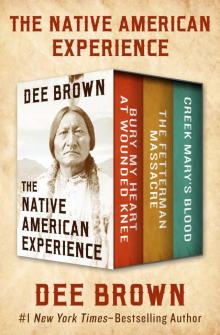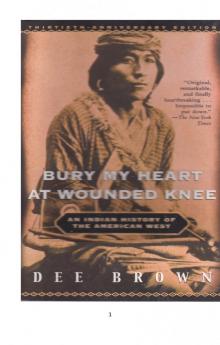Saga of the Sioux Read online
Page 15
Black Hills (Paha Sapa); Custer’s expedition to; negotiations for mineral rights to; relinquishment of, proposed to Indians; Sioux Nation’s legal fight to regain; taken from Indians; treaty recognizing Sioux ownership of
Black Horse
Bozeman Trail; attacks on forts along; Carrington regiment’s advance along; closing of; forts constructed on; treaty commission of 1866 and
Brave Bear
Brughiere, Johnny
Brulés, See also Spotted Tail
Buchanan, James
Buffalo
Buffalo Bill’s Wild West Show
Buffalo-Calf-Road-Woman
Bull Bear
Bull Head
Calendar of Sioux
Camp Release
Camp Robinson (later Fort Robinson)
Canada: Santees’ flight to; Sitting Bull’s exile in
Carlisle Indian Industrial School
Carrington, Henry B.; Cheyenne chiefs’ meeting with; treaty commission of 1866 and
Catch-the-Bear
Cedar Creek, Battle of
Cheyenne River agency
Cheyennes; Battle of the Rosebud and; Fetterman Massacre and; Hayfield Battle and; Mackenzie’s attack on village of; at Powder River; railroads attacked by; Reynolds’s attack on; white men’s incursions into Powder River country and. See also Dull Knife
Christianity: Ghost Dance movement and, Indians’ conversion to
Civil War
Cody, William F. “Buffalo Bill,”
Cole, Nelson
Comanches
Comes-in-Sight
Congress, U.S.
Connor, Patrick E.; Arapaho camp on Tongue River attacked by; , Fort Connor built by
Coup sticks
Crazy Horse (Thasunke Witko); at Battle of the Rosebud; killing of; negotiations over Black Hills and; reservation life refused by; , surrender of; visions of
Credit system
Crook, George; breakup of Great Sioux Reservation and
Crow Creek
Crow Dog
Crow Feather
Crow King
Crows
Custer, George Armstrong
Dakota Territory; flight of Little Crow and his followers to; Santees removed to reservation in. See also Standing Rock agency
Dawes, Henry L.
Dawes Act or Dawes Severalty Act (General Allotment Act of 1887)
Dawes commission
Dog Chief
Drum, William F.
Dull Knife (Tamilapesni)
Eagle Foot
Edmunds, Newton
Education of Indian children
Environmental destruction
Farming; allotment system and; assimilation and
Fetterman, William J.
Fetterman Massacre
Flat Hip
Fleet Foot
Forsyth, James W.
Fort Buford
Fort C. F. Smith; abandonment of; Cheyenne attack on
Fort Connor. See Fort Reno
Fort Fetterman
Fort Garry (renamed Winnipeg)
Fort Keogh
Fort Laramie; peace commissions of 1867 and 1868 at; treaty commission of 1866 at; , See also Treaty of Fort Laramie
Fort Philip Kearny; abandonment of; Red Cloud’s offensives against
Fort Randall
Fort Reno (formerly Fort Connor); abandonment of; siege of
Fort Rice
Fort Ridgely, attack on
Fort Robinson. See Camp Robinson
Fort Snelling
Fort Walsh
Fort Yates
Galbraith, Thomas
Gall
General Allotment Act of 1887 (Dawes Act or Dawes Severalty Act)
Gentles, William
Geronimo
Ghost Dance; Wounded Knee Massacre and
Gibbon, John
Godfrey (mulatto)
Gold: in Black Hills; Sawyer’s wagon train and
Grant, Ulysses S.
Grass, John
Great Sioux Nation
Great Sioux Reservation; breaking up and selling of lands in
Gros Ventres (Atsinas)
Harney, William S.
Hatch, Edwin
Hayfield Battle
High Back Bone
High Hawk
Hinman, Rev. Samuel D.
Hollow Horn Bear
Hotchkiss guns
Hump
Hunkpapas; Battle of Cedar Creek and; Cole and Walker’s columns harassed by; , at Little bighorn; See also Gall; Sitting Bull
Indian Bureau
“Indians,” use of term
Indian Territory (Oklahoma)
International Indian Treaty Council
Iron Thunder
Joseph, Chief
Kennington, James
Kicking Bear
Kill Eagle
Lakota; proposed Republic of
Lakota Freedom Delegation
Lame Deer
Land ownership, allotment system and
Laramie Loafers
Lightning Blanket
Lincoln, Abraham
Little Bighorn, Battle of
Little Big Man
Little Crow (Ta-oya-te-duta); as Episcopalian; flight of, to Dakota Territory; killing of
Little Crow’s War; Birch Coulee Battle in; circumstances leading to; executions of Santees after; Fort Ridgely attacked in; killing incident at start of; map showing important landmarks and battles in; military trials after; New Ulm Battle in; Santees fleeing to Dakota Territory and Canada after; Santees kept prisoner after; Sibley’s communications with Little Crow and; surrender of noncombatant Santees in; Wabasha’s betrayal in; white prisoners in; white refugees in
Little Horse
Little Powder River, Reynolds’s attack on camp at
Little Wolf
Little Wound
Logan, John
Longfellow, Henry Wadsworth
Lower Sioux Agency
Mackenzie, Ranald S.
MacLeod, James
Man-Afraid-of-His-Horses (later known as Old-Man-Afraid-of-His-Horses)
Mankato (Santee chief)
Mankato (town), executions in
Manypenny, George
Marsh, John
Maynadier, Henry
Mazakootemane, Paul
McGillycuddy, Valentine
McKenzie, John
McLaughlin, James
Mdewakantons. See also Little Crow
Means, Russell
Medal of Honor
Medicine Bottle
Mendota, Treaty of
Miles, Nelson A.
Mills, Anson
Minneconjous; Cole and Walker’s columns harassed by; , Fetterman Massacre and; at Little Bighorn; massacred at Wounded Knee
Minnesota; bounty paid for Sioux scalps in; Little Crow’s War in,
(see also Little Crow’s War); Santees removed from; Sioux agencies in
Missionaries
Missouri River, Indian lands along; reservation Sioux relocated from Nebraska to
Montana Territory
Myrick, Andrew
National Congress of American Indians
“Native American,” use of term
New Ulm
Nez Percés
Nichol, Fred
North, Frank
Northern Pacific Railroad
Office of Indian Affairs
Oglalas; attack on American Horse’s village and; Battle of the Rosebud and; Carrington’s troops harassed by; Fetterman Massacre and; final flight and surrender of; at Little bighorn; railroads attacked by; reservation left by; treaty commission of 1866 and; white men’s incursions into Powder River country and. See also Crazy Horse; Red Cloud
Ojibwas
Paha Sapa. See Black Hills
Paiutes
Panther
Parker, Quanah
Pawnee Killer
Pawnees
Pine Ridge agency (later Pine Ridge Reser
vation)
Pope, John
Powder River country; attack on Arapaho village in (Tongue River); Carrington regiment’s occupation of; Cole and Walker’s columns in; Connor’s launching of invasion in; forts in,(see also Fort Philip Kearny; Fort Reno); lands set aside for Sioux in; map of; railroads attacked in; Sawyers’s wagon train in; taken from Indians; treaty commission of 1866 in
Pte-San-Waste-Win (Pretty Gray Cow)
Railroads; Indian raids on; shooting buffalo from; Sitting Bull’s ceremonial speeches and
Rain-in-the-Face
Ramsey, Alexander
Rda-in-yan-ka
Red Cloud (Mahpiua-luta); arsenal assembled by; breakup of Great Sioux Reservation and; death of; decline in authority of; invasion of Black Hills (Paha Sapa) and; move to reservation and; in negotiations of 1875 over Black Hills; peace commissions of 1867 and 1868 and; treaty commission of 1866 and
Red Cloud agency
Red Cloud’s War; causes of; decoy tricks in; ended by Treaty of Fort Laramie; Fetterman Massacre in; guerrilla warfare in; offensives against Fort Philip Kearny in; peace commissions and; warriors assembled for
Red Dog
Red Horse
Red Tomahawk
“Reform” of Indian nations
Reno, Marcus
Reservations (agencies); Indians refusing to move to; nonreservation Indians ordered to; put under military control; Treaty of Fort Laramie (1868) and. See also Great Sioux Reservation
Reyolds, Joseph J.
Richard, Louis
Rifles
Roman Nose (Woqini)
Roman Nose’s Fight
Rosebud, Battle of
Rosebud agency
Sanborn, John
Sans Arcs
Santees; Ramsey’s call for extermination or exile of; removed to reservation in Dakota Territory. See also Little Crow; Little Crow’s War
Saville, J. J.
Sawyers, James A.
Settlers, white; killings of; right of passageway across Indian country for
Shakopee
Sheehan, Timothy
Sheridan, Philip
Sherman, William Tecumseh
Short Bull
Sibley, Henry H.; Little Crow’s War and
Sioux; beliefs of; calendar of; council gatherings of; groups of; language dialects of; origin of term; territory of. See also specific bands or tribes
Sissetons
Sitting Bull (Tatanka Yotanka); attempts to diminish influence of; breakup of Great Sioux Reservation opposed by; in Buffalo Bill’s Wild West Show; in exile in Canada; family of; Ghost Dance and; grave of; imprisonment of; killing of; Miles’s parlay with; negotiations over Black Hills and; prophecy of; public appearances of; reservation life refused by
Sleeping Rabbit
Smith, Edward P.
Sorrel Horse
Spotted Tail (Sinte Gleska); assassination of; move to reservation and; negotiations over Black Hills and
Spotted Tail agency
Springfield repeating rifles
Standing Elk
Standing Rock agency (later Standing Rock Reservation)
Sun Dance
Supreme Court, U.S.
Swift Bear
Taylor, E. B.
Taylor, Nathaniel
Tecumseh
Telegraph
Terry, Alfred H.
Thieves’ Road
Tongue River, Battle of
Tosawi
Touch-the-Clouds
Trader Indians
Traders; credit system and; at Upper and Lower Sioux agencies
Traveling Hail
Traverse des Sioux, Treaty of
Travois
Treaties; for right of passageway across Indian country
Treaty of Fort Laramie (1868); breaking of
Two Moon
Union Pacific Railroad
United Nations
United States v. Sioux Nation of Indians
Upper Sioux Agency
Vision ceremony
Wabasha
Wagon Box Battle
Wahpetons
Wakantanka (Great Spirit)
Walker, Samuel
Walker Lake agency
War Department
Wasumaza (later Dewey Beard)
Watkins, E. C.
Weasel Bear, Louise
Whipple, Bishop Henry
Whirlwind
White Bull
White Lance
Whitside, Samuel
Williford, George
Wilson, Dick
Wolf Mountain, Battle of
Wood Lake
Wounded Knee Creek
Wounded Knee Massacre; Ghost Dance and; medals awarded for; site of
Wovoka
Wowinapa
Yellow Bird
Yellow Eagle
Young-Man-Afraid-of-His-Horses
Adapting one of the benchmark histories of the American West for a younger audience was both a tremendous opportunity and a tremendous obligation. I am profoundly grateful for the help and support of a number of people. First and foremost among those is Linda Luise Brown, Dee Brown's daughter and head of his estate whose permission and encouragement made this edition possible. Sally Doherty and Rebecca Hahn provided invaluable guidance and suggestions in the many stages of the manuscript and image acquistion process. I must also thank Patrick Collins and Meredith Pratt for their enthusiasm and skill in turning the many raw elements into a polished book. I am grateful that my daughter, Léa Zimmerman, agreed to help her harried father and create the maps that are so essential in making clear the complex movements that occur during a battle. I am especially grateful to my agent, George Nicholson of Sterling Lord Literistic, whose support and dedication throughout this project never wavered. Finally, I must thank my wife, Joë lle, for her common sense and wisdom in yet another marathon effort of writing.
For a complete list of Dee Brown’s original source material, see Bury My Heart at Wounded Knee, from which this book is derived. Sources for the Introduction and Epilogue include Encyclopedia of the Great Plains, David J. Wishart, editor (Lincoln: University of Nebraska Press, 2004); Republic of Lakotah website (www.republicoflakotah.com); U.S. v. Dennis Banks, 73-5034, 73-5062, 14, 15 (1974); U.S. v. Russell Means, 73-5035, 73-5063, 14, 15 (1974).
Image credits: here–here, istockphoto 7667507 © Ken Canning; here, © Jim Cortez ; here, New Ulm map courtesy of the Library of Congress Geography and Map Division, Call # G4144.N4A3 1870.R8 Rug 112; here, Fort Philip Kearney map courtesy of Wikipedia; here, postage stamp of Crazy Horse courtesy of the U.S. Postal Service. All other images courtesy of the Library of Congress Prints and Photographs Online Catalog; reproduction numbers are included with each caption.
Frontispiece: Brulé chief Hollow Horn Bear, a leader in the Fetterman Massacre. [LOC, USZ62-53674]
Henry Holt and Company, LLC
Publishers since 1866
175 Fifth Avenue
New York, New York 10010
mackids.com
Henry Holt © is a registered trademark of Henry Holt and Company, LLC.
Copyright © 2011 by The Dee Brown LLC
All rights reserved.
eBooks may be purchased for business or promotional use. For information on bulk purchases, please contact Macmillan Corporate and Premium Sales Department by writing to [email protected].
Library of Congress Cataloging-in-Publication Data
Brown, Dee Alexander.
Saga of the Sioux: an adaptation from Dee Brown's Bury My Heart at Wounded Knee /
[adapted by] Dwight Jon Zimmerman.
p. cm.
Includes bibliographical references.
eISBN: 978-1-4668-8261-4
1. Indians of North America—Wars—West (U.S.) 2. Indians of North America—West (U.S.)
3. West (U.S.)—History. I. Zimmerman, Dwight Jon. II. Brown, Dee Alexander.
Bury my heart at Wounded Knee. I
II. Title.
E81.B754 2011 978—dc22 2011004792
First Edition—2011

 The Native American Experience
The Native American Experience Bury My Heart At Wounded Knee
Bury My Heart At Wounded Knee Action at Beecher Island: A Novel
Action at Beecher Island: A Novel Saga of the Sioux
Saga of the Sioux